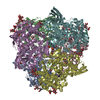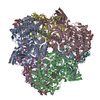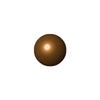[English] 日本語
 Yorodumi
Yorodumi- PDB-8ca9: Cryo-EM structure of the Cibeles-Demetra 3:3 heterocomplex from G... -
+ Open data
Open data
- Basic information
Basic information
| Entry | Database: PDB / ID: 8ca9 | ||||||||||||||||||||||||
|---|---|---|---|---|---|---|---|---|---|---|---|---|---|---|---|---|---|---|---|---|---|---|---|---|---|
| Title | Cryo-EM structure of the Cibeles-Demetra 3:3 heterocomplex from Galleria mellonella saliva | ||||||||||||||||||||||||
 Components Components |
| ||||||||||||||||||||||||
 Keywords Keywords | UNKNOWN FUNCTION / Galleria mellonella / Wax worm saliva / Plastic degradation / Polyethylene degradation / PEases / Hexamerin / Hemocyanin/phenoloxidase superfamily / Metal binding / Arylphorin | ||||||||||||||||||||||||
| Function / homology |  Function and homology information Function and homology information | ||||||||||||||||||||||||
| Biological species |  Galleria mellonella (greater wax moth) Galleria mellonella (greater wax moth) | ||||||||||||||||||||||||
| Method | ELECTRON MICROSCOPY / single particle reconstruction / cryo EM / Resolution: 2.29 Å | ||||||||||||||||||||||||
 Authors Authors | Spinola-Amilibia, M. / Arias-Palomo, E. | ||||||||||||||||||||||||
| Funding support |  Germany, Germany,  Belgium, Belgium,  Spain, 7items Spain, 7items
| ||||||||||||||||||||||||
 Citation Citation |  Journal: Sci Adv / Year: 2023 Journal: Sci Adv / Year: 2023Title: Plastic degradation by insect hexamerins: Near-atomic resolution structures of the polyethylene-degrading proteins from the wax worm saliva. Authors: Mercedes Spínola-Amilibia / Ramiro Illanes-Vicioso / Elena Ruiz-López / Pere Colomer-Vidal / Francisco Rodriguez-Ventura / Rosa Peces Pérez / Clemente F Arias / Tomas Torroba / Maria ...Authors: Mercedes Spínola-Amilibia / Ramiro Illanes-Vicioso / Elena Ruiz-López / Pere Colomer-Vidal / Francisco Rodriguez-Ventura / Rosa Peces Pérez / Clemente F Arias / Tomas Torroba / Maria Solà / Ernesto Arias-Palomo / Federica Bertocchini /  Abstract: Plastic waste management is a pressing ecological, social, and economic challenge. The saliva of the lepidopteran larvae is capable of oxidizing and depolymerizing polyethylene in hours at room ...Plastic waste management is a pressing ecological, social, and economic challenge. The saliva of the lepidopteran larvae is capable of oxidizing and depolymerizing polyethylene in hours at room temperature. Here, we analyze by cryo-electron microscopy (cryo-EM) 's saliva directly from the native source. The three-dimensional reconstructions reveal that the buccal secretion is mainly composed of four hexamerins belonging to the hemocyanin/phenoloxidase family, renamed Demetra, Cibeles, Ceres, and a previously unidentified factor termed Cora. Functional assays show that this factor, as its counterparts Demetra and Ceres, is also able to oxidize and degrade polyethylene. The cryo-EM data and the x-ray analysis from purified fractions show that they self-assemble primarily into three macromolecular complexes with striking structural differences that likely modulate their activity. Overall, these results establish the ground to further explore the hexamerins' functionalities, their role in vivo, and their eventual biotechnological application. | ||||||||||||||||||||||||
| History |
|
- Structure visualization
Structure visualization
| Structure viewer | Molecule:  Molmil Molmil Jmol/JSmol Jmol/JSmol |
|---|
- Downloads & links
Downloads & links
- Download
Download
| PDBx/mmCIF format |  8ca9.cif.gz 8ca9.cif.gz | 1.4 MB | Display |  PDBx/mmCIF format PDBx/mmCIF format |
|---|---|---|---|---|
| PDB format |  pdb8ca9.ent.gz pdb8ca9.ent.gz | 1.2 MB | Display |  PDB format PDB format |
| PDBx/mmJSON format |  8ca9.json.gz 8ca9.json.gz | Tree view |  PDBx/mmJSON format PDBx/mmJSON format | |
| Others |  Other downloads Other downloads |
-Validation report
| Summary document |  8ca9_validation.pdf.gz 8ca9_validation.pdf.gz | 2.3 MB | Display |  wwPDB validaton report wwPDB validaton report |
|---|---|---|---|---|
| Full document |  8ca9_full_validation.pdf.gz 8ca9_full_validation.pdf.gz | 2.4 MB | Display | |
| Data in XML |  8ca9_validation.xml.gz 8ca9_validation.xml.gz | 110.5 KB | Display | |
| Data in CIF |  8ca9_validation.cif.gz 8ca9_validation.cif.gz | 182 KB | Display | |
| Arichive directory |  https://data.pdbj.org/pub/pdb/validation_reports/ca/8ca9 https://data.pdbj.org/pub/pdb/validation_reports/ca/8ca9 ftp://data.pdbj.org/pub/pdb/validation_reports/ca/8ca9 ftp://data.pdbj.org/pub/pdb/validation_reports/ca/8ca9 | HTTPS FTP |
-Related structure data
| Related structure data |  16521MC  8cadC  8canC  8po9C M: map data used to model this data C: citing same article ( |
|---|---|
| Similar structure data | Similarity search - Function & homology  F&H Search F&H Search |
- Links
Links
- Assembly
Assembly
| Deposited unit | 
|
|---|---|
| 1 |
|
- Components
Components
-Protein , 2 types, 6 molecules ABCDEF
| #1: Protein | Mass: 83778.000 Da / Num. of mol.: 3 / Source method: isolated from a natural source / Source: (natural)  Galleria mellonella (greater wax moth) / References: UniProt: Q24995 Galleria mellonella (greater wax moth) / References: UniProt: Q24995#2: Protein | Mass: 83310.484 Da / Num. of mol.: 3 / Source method: isolated from a natural source / Source: (natural)  Galleria mellonella (greater wax moth) Galleria mellonella (greater wax moth) |
|---|
-Sugars , 4 types, 12 molecules
| #3: Polysaccharide | Source method: isolated from a genetically manipulated source #4: Polysaccharide | Source method: isolated from a genetically manipulated source #5: Polysaccharide | Source method: isolated from a genetically manipulated source #6: Polysaccharide | Source method: isolated from a genetically manipulated source |
|---|
-Non-polymers , 2 types, 2110 molecules 


| #7: Chemical | | #8: Water | ChemComp-HOH / | |
|---|
-Details
| Has ligand of interest | Y |
|---|---|
| Has protein modification | Y |
-Experimental details
-Experiment
| Experiment | Method: ELECTRON MICROSCOPY |
|---|---|
| EM experiment | Aggregation state: PARTICLE / 3D reconstruction method: single particle reconstruction |
- Sample preparation
Sample preparation
| Component | Name: Cibeles-Demetra heterocomplex / Type: COMPLEX Details: Complex of two trimeric rings of Cibeles and Demetra Entity ID: #1-#2 / Source: NATURAL | |||||||||||||||||||||||||
|---|---|---|---|---|---|---|---|---|---|---|---|---|---|---|---|---|---|---|---|---|---|---|---|---|---|---|
| Molecular weight | Experimental value: NO | |||||||||||||||||||||||||
| Source (natural) | Organism:  Galleria mellonella (greater wax moth) Galleria mellonella (greater wax moth) | |||||||||||||||||||||||||
| Source (recombinant) | Organism:  | |||||||||||||||||||||||||
| Buffer solution | pH: 7.5 | |||||||||||||||||||||||||
| Buffer component |
| |||||||||||||||||||||||||
| Specimen | Embedding applied: NO / Shadowing applied: NO / Staining applied: NO / Vitrification applied: YES | |||||||||||||||||||||||||
| Specimen support | Details: 25 mA / Grid material: COPPER / Grid mesh size: 300 divisions/in. / Grid type: Quantifoil R2/1 | |||||||||||||||||||||||||
| Vitrification | Instrument: FEI VITROBOT MARK IV / Cryogen name: ETHANE / Humidity: 100 % / Chamber temperature: 298 K |
- Electron microscopy imaging
Electron microscopy imaging
| Experimental equipment |  Model: Titan Krios / Image courtesy: FEI Company |
|---|---|
| Microscopy | Model: FEI TITAN KRIOS |
| Electron gun | Electron source:  FIELD EMISSION GUN / Accelerating voltage: 300 kV / Illumination mode: FLOOD BEAM FIELD EMISSION GUN / Accelerating voltage: 300 kV / Illumination mode: FLOOD BEAM |
| Electron lens | Mode: BRIGHT FIELD / Nominal defocus max: 2600 nm / Nominal defocus min: 1100 nm / Cs: 2.7 mm |
| Specimen holder | Cryogen: NITROGEN / Specimen holder model: FEI TITAN KRIOS AUTOGRID HOLDER |
| Image recording | Average exposure time: 5.5 sec. / Electron dose: 58.3 e/Å2 / Film or detector model: GATAN K3 BIOQUANTUM (6k x 4k) / Num. of real images: 6386 Details: Images were collected in super-resolution mode (pixel size of 0.543 angstrom) |
- Processing
Processing
| Software | Name: PHENIX / Version: 1.19.2_4158: / Classification: refinement | ||||||||||||||||||||||||||||||||||||||||
|---|---|---|---|---|---|---|---|---|---|---|---|---|---|---|---|---|---|---|---|---|---|---|---|---|---|---|---|---|---|---|---|---|---|---|---|---|---|---|---|---|---|
| EM software |
| ||||||||||||||||||||||||||||||||||||||||
| Image processing | Details: Super-resolution counting mode | ||||||||||||||||||||||||||||||||||||||||
| CTF correction | Type: PHASE FLIPPING AND AMPLITUDE CORRECTION | ||||||||||||||||||||||||||||||||||||||||
| Particle selection | Num. of particles selected: 1826686 / Details: Autopicking from relion_3.1 with two templates | ||||||||||||||||||||||||||||||||||||||||
| Symmetry | Point symmetry: C3 (3 fold cyclic) | ||||||||||||||||||||||||||||||||||||||||
| 3D reconstruction | Resolution: 2.29 Å / Resolution method: FSC 0.143 CUT-OFF / Num. of particles: 152240 / Num. of class averages: 3 / Symmetry type: POINT | ||||||||||||||||||||||||||||||||||||||||
| Atomic model building | B value: 45.533 / Protocol: AB INITIO MODEL / Space: REAL | ||||||||||||||||||||||||||||||||||||||||
| Refine LS restraints |
|
 Movie
Movie Controller
Controller




 PDBj
PDBj
